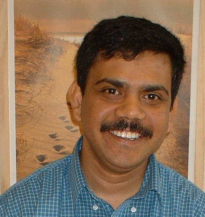Ordered and Disordered Porous Materials for nanofiltration application
Promotion Date: 06 April 2005
| It was mainly a chemical engineering project, with some material science. The idea of the project was to recover the catalyst from a complex reaction in order to use the catalyst again. This is for economic reasons important to industry, the metal ions, they use are expensive to make. So the aim was to at least recover 90 % of the catalyst, within a reasonable time span. I also investigated how you achieve a greater regularity in porous membrane structures by depositing a silica layer based on a liquid crystalline structure (used as a mould) on a gamma alumina support. This very ordered structure may be used for liquid separation. |
What was your thesis about?
It was mainly a chemical engineering project, with some material science. The idea of the project was to recover the catalyst from a complex reaction in order to use the catalyst again. This is for economic reasons important to industry, the metal ions, they use are expensive to make. So the aim was to at least recover 90 % of the catalyst, within a reasonable time span.
I also investigated how you achieve a greater regularity in porous membrane structures by depositing a silica layer based on a liquid crystalline structure (used as a mould) on a gamma alumina support. This very ordered structure may be used for liquid separation.
And did you manage to recover the catalyst?
Yes, I managed to recover 99,9%. For me the project really worked very well.
So you were successful right from the start?
Basically, yes. Hardly any Ph.D. project works that way, I was extremely lucky. I did have a problem though, but it was not related to the process. I had to explain and interpret what I was getting and that was difficult. We weren’t sure from a scientific point of view what we were seeing and why. That was the tough time. Because obviously in a scientific research you must be able to explain what is going on. To discover that I sidestepped to geology to get a better understanding of the material itself, the porous rocks and their properties. That put me on the right track, because there were similar phenomena albeit on a very small scale in my research.
We could propose a theory that the scientific community accepted. I published an article in Langmuir about it. The explanation comes from the surface science, the bridging block in the two sciences, chemical engineering and geology.
Did you study geology at all?
At the end of my school days I did a special course on geology and geomorphology and also in my undergraduation I had a specialization of petroleum reserve engineering and refinery engineering. So some principles were not completely unfamiliar.
What kind of industries were interested to retrieve their catalysts?
Chemical companies, pharmaceutical companies, like DSM for instance. So now nanotechnology (membrane technology) is applied in chemical industries. Of course surface science (stability and instability of suspensions) is always on a nano level, but we do not always know it.
So you already published an article about this?
I have nine published articles that contain my name. I will write another four by converting my thesis chapters into articles. I have a contract until the end of May and must finish before that time.
You are from India. How did you come to Mesa?
Via the Internet. I browsed through some web pages and found this position. And I applied. I was invited to come for an interview, everything paid for. So I did not hesitate, since it was going to be my first trip abroad. And I got the offer and accepted it. After that it took quite some time to actually get here, because my papers were mislaid at the Netherlands Embassy in New Dehli. Instead of sending files to Calcutta they sent them to Bombay. This was really upsetting.
Tell me something of your culture shock I getting here.
True, it was a culture shock. I’d be a telling lie if I call it anything else. The weather and so on. But I will tell you this: I arrived on Good Friday and everything was closed. When I went to get my room keys from the main gate of the university, I did not only get keys but also a bag filled with necessities like food and drink and toilet paper. Our Group Secretary arranged that. That was very kind indeed, and it was a very good first impression of the Dutch that I will always remember.
For the summary of the thesis, click here.

